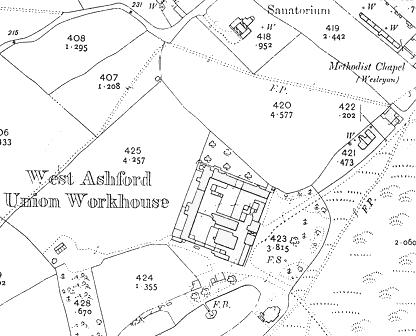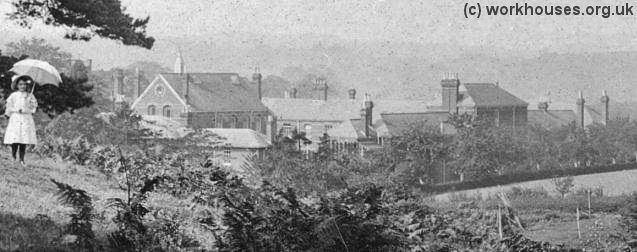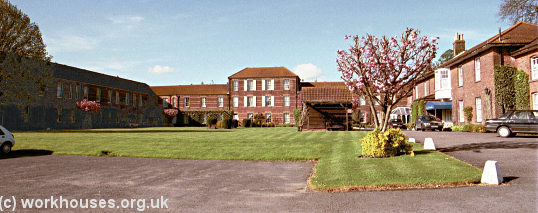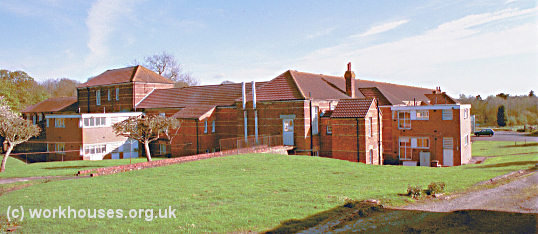West Ashford, Kent
Up to 1834
A new building, part workhouse and part house of correction, was erected in Ashford in 1705. References to the house of correction continue until 1732.
In 1770, the Ashford workhouse rules specified that entrants to the establishment had to be approved by two of Committee. On entry they were to be clean and, if necessary, clothed. The able-bodied had to work from 6a.m. to 6p.m. in summer and from 7a.m. to 6p.m. (or until dark) in winter. There was half-hour breaks at 8a.m. for breakfast and at noon for dinner. There was a roll call after supper and absentees were punished. All had to be in bed by 9p.m. in summer and 8p.m. in winter. There rooms were fumigated with wormwood. Smoking was only allowed in the Common Room. No spirits were allowed in the House. Children were to attend school in House between the ages of 3 and 6 years. Children aged 5 to 12 years were allowed one hour from work to receive instruction in reading. Girls to be instructed in cooking, washing etc. to qualify them for service.
A parliamentary report of 1777 recorded parish workhouses in operation in Ashford (for up to 70 inmates), Bethersden (20), Charing (2), Kingsnorth (12), and Westwell (10).
Eden, in his 1797 survey of the poor in England, reported on several parishes in the Ashford area:
Ashford — Some Poor are maintained at home, others in the Workhouse, where there are 60 at present. They are chiefly employed in a bleachery recently established for bleaching Irish linen, and earn about 1s. a week. The allowance to out poor does not exceed 1s. a week to a single person, 2s. to two in a house, and 2s. 6d. to a family. About 2 removals every year. Very few certificates. One friendly society, chiefly for the benefit of widows of deceased members. Poverty is generally ascribed to the low rate of wages and high price of provisions. They suit each other very well in summer, but not in winter. The Poor in most parts of Kent ten years ago always ate meat daily. Now they seldom taste it in winter, except in a Poor-house. Private brewing, even among small farmers, is at an end; the Poor drink tea at all their meals, which, with bread, potatoes and cheese, constitutes their chief diet.
Great Chart — The Poor are partly maintained at home, partly in a Workhouse. The parish officers expect a labourer to maintain 3 children. They allow 1s. a week for every child beyond 3, or permit the parents to send it to the Workhouse.
Hothfield — The Poor are relieved at home. Half the labouring Poor are certificated persons from other parishes. The common, which affords them the means of keeping a cow or poultry, is supposed to draw many Poor into the parish.
Westwell — The Poor are maintained at home; for three years they were employed in a Poor-house in weaving, etc. This did not answer, and the house has lately been discontinued. The Poor are not well managed in this parish. The general diet of the Poor in the Weald is bread, milk, tea and cheese; little or no milk is used; very little beer, and no butter.
After 1834
West Ashford Poor Law Union was formed on 3rd June 1835. Its operation was overseen by an elected Board of Guardians, 12 in number representing the its 12 constituent parishes as listed below:
Kent: Ashford*, Bethersden, Charing, Great Chart, Little Chart*, Egerton, Hothfield, Kingsnorth, Pluckley, Smarden, Shadoxhurst, Westwell. (* indicates additions from 25th April 1836)
The population falling within the (enlarged) Union at the 1831 census had been 10,758 with parishes ranging in size from Shadoxhurst (population 239) to Ashford (2,809). The average annual poor-rate expenditure for the period 1833-5 had been £12,349 or £1.2s.11d. per head of the population.
In 1835, the West Ashford Union erected a workhouse at Hothfield Common. It was designed to accommodate 240 inmates and was based on Sir Francis Head's model courtyard design which was also adopted by other Kent Unions such as Bridge, Cranbrook, Dartford, Eastry, Malling, and Tonbridge. The layout and location of the West Ashford site is shown on the 1906 map below:

The buildings, constructed in plain red brick, were of two or three storeys. The entrance was originally through a gateway at the east of the site. There were also two large buildings in the courtyard itself, now demolished.

West Ashford from the north-east, 1910.
© Peter Higginbotham.

West Ashford from the south, 2001.
© Peter Higginbotham.

West Ashford from the north-west, 2001.
© Peter Higginbotham.
A major renovation costing £5,000 took place in 1902 with the creation of a an infirmary and school for 33 children
After 1929, the establishment came under the control of Kent County Council and was renamed Hothfield Public Assistance Institution. In 1941, the premises were taken over as a 150-bed military hospital. At one point, following the evacuation of Dunkirk, approximately 15,000 men were camping on nearby Hothfield Common with those needing treatment attending the out-patients department each day.
After 1948, the site became Hothfield Hospital. It has now been converted for use as a private nursing home.
Staff
Inmates
Records
Note: many repositories impose a closure period of up to 100 years for records identifying individuals. Before travelling a long distance, always check that the records you want to consult will be available.
- Kent History and Library Centre, James Whatman Way, Maidstone, Kent ME14 1LQ Holdings include: Guardians' minutes (1835-1930); Admissions and discharge registers (1863-1932); Porter's admission and discharge books (1904-7); Births (1836-1913); Deaths (1836-1906); Creed registers (1869-1939); Register of mechanical restraint (1896-1923); etc.
Bibliography
- Higginbotham, Peter Workhouses of London and the South East (2019)
Links
- None.
Unless otherwise indicated, this page () is copyright Peter Higginbotham. Contents may not be reproduced without permission.


